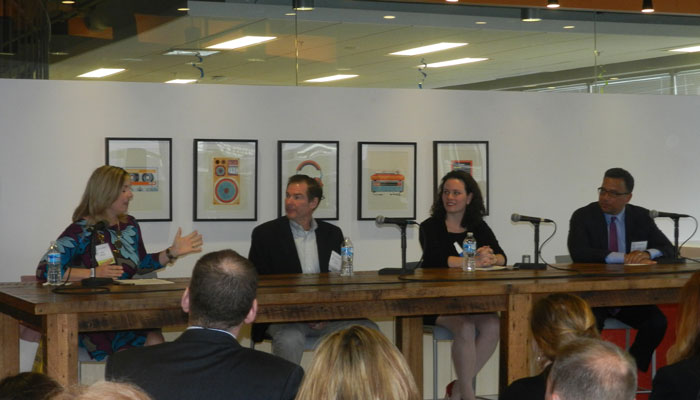C-suite observations on how to maximize the profitability of your most valuable asset: your employees
(Oakton, Va. – April 14, 2016) Being a leader in today’s business world no longer means simply conducting business within a community. It requires being a part of that community — including the creation of a workplace community, one in which employees are eager to come to work each day and perform to the best of their abilities for an organization they’re passionate to support.
Such employee engagement is critical to business success, as panelists for “The Business Case for ‘A Best to Place to Work’” readily attested. The panel, sponsored by Northern Virginia Family Service and the CARE Awards, focused on how employee engagement affects the bottom line, how companies measure such engagement and how they use it to sustain a competitive edge.

To start, make sure you’re measuring the right component. “Employee satisfaction is different than engagement,” shared Ashley Larson, vice president of Washington, D.C.-based Revolution Growth. “Engagement is about passion. It’s about employees running through brick walls for a company, even during difficult times.”
The keys to employee engagement, she added, are that employees feel good about their growth opportunities, have the tools they need to succeed and feel rewarded for a job well done.
Here’s how you can turn your team into a thriving, engaging workforce:
- Be cognizant of the words you use to define your company, and infuse them into the daily office routine. Becoming a best place to work isn’t a step-by-step process — it’s part of the day-to-day work, stated Kevin Cheetham, chief financial officer at Fairfax, Va.-based CustomInk.
“Here, we don’t use the word culture – we use the word character,” he added. “Character is driven by our core values: the ‘golden rule,’ ownership and innovation. How we approach people and culture manifests itself in the work we do.”
CustomInk awards its employees annually based on these core values and uses employee satisfaction as a key metric in its employee review process.
- Measure employee satisfaction — and track it against other metrics, such as consumer satisfaction. Employee satisfaction is important at all levels of the organization, from senior leadership to hourly workers. But it needs to be tracked against other important key performance indicators (KPIs), such as profitability per employee and net promoter score, and reported back to employees to close the loop and drive further success. Without such comparative measurements, it can be hard to determine if you’re spending money to increase productivity or just to keep employees happy.
- Recruit top players. “’A’ players beget ‘A’ players,” Larson noted. “’B’ players beget ‘C’ and ‘D’ players.”
Being a “best place to work” is one way to attract top performers. But employees also need to fit the culture of the organization. Indexes such as Talent+ and ghSmart are useful tools to determine compatibility. So is the perspective of various employees, which is why it’s important to conduct multiple interviews across the company when hiring.
- Reward top-performing employees. Perks such as gift cards and giveaways are nice, but real rewards bolster the type of engagement needed to sustain a successful business. Take Towne Park’s Winners Circle, for example.
The top 5 percent [of our employees in the field] are rewarded with a trip with their spouse,” Chief Executive Officer Chuck Heskett explained. “When they come back, it makes the rest of the team run a little faster.”
- Be approachable. Employees work harder for people whom they think have their best interests at heart. That includes direct supervisors all the way up to the CEO.
“As a CEO, you’re not full of yourself, but you have the knowledge that the title holds weight,” Heskett observed. Little details, such as acknowledging employees by name or even decorating an office to appear more open and welcoming, can make a big difference to employees.
One of the easiest steps toward becoming a “best place to work” is to apply to be one. The CARE Awards application is now open, with a deadline of May 18. The process involves an introductory application, followed by an employee survey in June for those selected as semifinalists. Finalists will receive site visits between July and September, and winners will be announced at our CARE Awards Breakfast Nov. 18.
Although the application process is rigorous, even companies that have applied but not been selected have considered the process a valuable effort for insights into how they are supporting their employees and where they can improve. To learn more, visit nvfs.org/careawards.


